包豪斯英文简介
- 格式:ppt
- 大小:660.50 KB
- 文档页数:5
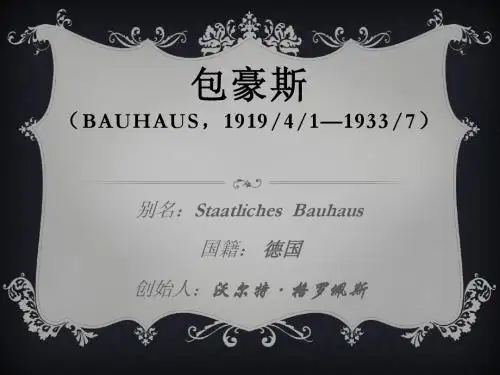

包豪斯名词解释
包豪斯(Bauhaus,1919/4/1—1933/7),是德国魏玛市的“公立包豪斯学校”(Staatliches Bauhaus)的简称,后改称“设计学院”(Hochschule für Gestaltung),习惯上仍沿称“包豪斯”。
在两德统一后位于魏玛的设计学院更名为魏玛包豪斯大学(Bauhaus-Universität Weimar)。
它的成立标志着现代设计教育的诞生,对世界现代设计的发展产生了深远的影响,包豪斯也是世界上第一所完全为发展现代设计教育而建立的学院。
包豪斯风格成为了现代主义风格的代名词。
“包豪斯”一词是德国建筑师瓦尔特·格罗皮乌斯(格罗佩斯)创造出来的,是德语Bauhaus的译音,由德语Hausbau(房屋建筑)一词倒置而成,后由德国建筑师密斯·凡德罗发扬光大。
在设计理论上,包豪斯提出了三个基本观点:
①艺术与技术的新统一:
②设计的目的是人而不是产品:
③设计必须遵循自然与客观的法则来进行。
这些观点对于工业设计的发展起到了积极的作用,使现代设计逐步由理想主义走向现实主义,即用理性的、科学的思想来代替艺术上的自我表现和浪漫主义。

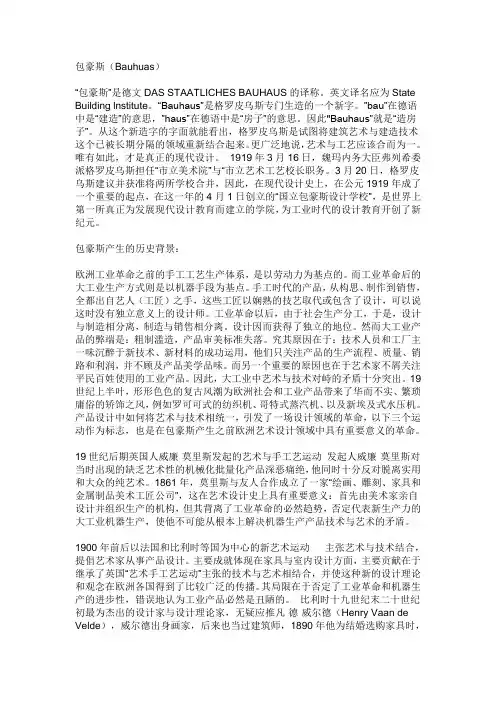
包豪斯(Bauhuas)“包豪斯”是德文DAS STAATLICHES BAUHAUS的译称。
英文译名应为State Building lnstitute。
“Bauhaus”是格罗皮乌斯专门生造的一个新字。
”bau”在德语中是“建造”的意思,”haus”在德语中是“房子”的意思。
因此"Bauhaus”就是“造房子”。
从这个新造字的字面就能看出,格罗皮乌斯是试图将建筑艺术与建造技术这个已被长期分隔的领域重新结合起来。
更广泛地说,艺术与工艺应该合而为一。
唯有如此,才是真正的现代设计。
1919年3月16日,魏玛内务大臣弗列希委派格罗皮乌斯担任“市立美术院”与“市立艺术工艺校长职务。
3月20日,格罗皮乌斯建议并获准将两所学校合并,因此,在现代设计史上,在公元1919年成了一个重要的起点,在这一年的4月1日创立的“国立包豪斯设计学校”,是世界上第一所真正为发展现代设计教育而建立的学院,为工业时代的设计教育开创了新纪元。
包豪斯产生的历史背景:欧洲工业革命之前的手工工艺生产体系,是以劳动力为基点的。
而工业革命后的大工业生产方式则是以机器手段为基点。
手工时代的产品,从构思、制作到销售,全都出自艺人(工匠)之手,这些工匠以娴熟的技艺取代或包含了设计,可以说这时没有独立意义上的设计师。
工业革命以后,由于社会生产分工,于是,设计与制造相分离,制造与销售相分离。
设计因而获得了独立的地位。
然而大工业产品的弊端是:粗制滥造,产品审美标准失落。
究其原因在于:技术人员和工厂主一味沉醉于新技术、新材料的成功运用,他们只关注产品的生产流程、质量、销路和利润,并不顾及产品美学品味。
而另一个重要的原因也在于艺术家不屑关注平民百姓使用的工业产品。
因此,大工业中艺术与技术对峙的矛盾十分突出。
19世纪上半叶,形形色色的复古风潮为欧洲社会和工业产品带来了华而不实、繁琐庸俗的矫饰之风,例如罗可可式的纺织机、哥特式蒸汽机、以及新埃及式水压机。

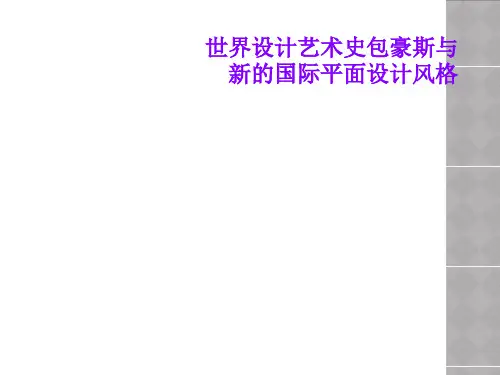


包豪斯“1903年,比利时画家兼建筑家享利·凡·德·威尔德(Henry Van de Velde)在德国魏玛创办了一所工艺美术学校,当时那里已经有一所旧式的美术学校,于是就考虑把两所学校并起来。
凡·德·威尔德认定德国建筑家瓦尔特·格罗皮乌斯(Walter Gropius)可以当好这所联合学校的校长,于是在1919年‘鲍豪斯’就成立起来了,鲍豪斯这个词的意思是‘房屋建造’,它所教授的东西,就以房屋的设计与建造为中心。
”(罗斯玛丽·兰伯特《剑桥艺术史》第250页)“Bauhaus[德],包豪斯:1919年在建筑家沃尔特·格罗皮乌斯[Walter Gropius]领导下设立于魏玛的设计学校。
该校对德意志工作联盟[DEUTSCHER WERKBUND]在战前开创的传统做了继承和发扬。
包豪斯的目的是要在以建筑为主的前提下把各种艺术综合起来。
在追随表现主义[EXPRESSIONISM]艺术家强调创作直觉一阵子后,包豪斯很快就转向现代工业世界。
它的教学方法强调从理性和实际去处理设计问题的必要性。
这些方法与构成主义[CONSTRUCTIVISM]、新造型主义[NEO-PLASTICISM]的新学说有联系。
”(爱德华·露西-史密斯《艺术词典》第21页)“包豪斯:格罗皮乌斯1919年在德国威玛建立的建筑设计学校,它拥有著名的画家、建筑家和雕塑家,很快就成为工业设计和建设的中心。
1925年搬到德绍。
1933年被纳粹封闭。
包豪斯在现代艺术中影响巨大,美国艺术家莫霍利-纳吉(Mo—holy—Nagy)于1937平还在芝加哥建立了新包豪斯(New Bauhaus)。
”(贡布里希《艺术发展史——“艺术的故事”》第456页)“鲍豪斯(Bauhaus):一所建筑、工艺、设计学校,由瓦尔特·格罗皮乌斯于1919年创建。
1926年迁往德绍,1932年迁往柏林,1933年被纳粹关闭。

BauhausThe Bauhaus is the best-known school of art,design and architecture of the twentiethcentury. Among its staff and students wereleading pioneers of early modernism in allareas of the arts and crafts, and the impact oftheir work and ideas has been felt in Europeand the United States for many years.Intended to represent a fresh start afterWorld War I, the school opened in 1919 underthe direction of the architect Walter Gropius, inthe buildings of the Weimar Academy of Art.In 1925 it moved to Dessau, a city withstronger industrial links, in new buildingsdesigned by Gropius. After being closed by thegovernment, the Bauhaus, now under Mies vander Rohe, operated in Berlin in 1932-3, until itwas closed once again by the Nazis.Extending the thinking of leading figures inthe Arts and Crafts movement in Britain suchas William Morris, C.R. Ashbee and W.R.Lethaby, Gropius hoped to reunite the fine and applied arts in the aftermath of the war. He attracted an impressive range of established artists to form the initial staff, including Wassily Kandinsky, Lyonel Feininger and Paul Klee(once a member of Der Blaue Reiter). Although these teachers were not architects, the school's aim was that all students should graduate in architecture, for it was believed that this discipline encapsulated(囊括) all other areas of art and design: In their first year students pursued the Vorkurs(预备课程), or foundation course, after which they studied in a workshop dedicated to materials, investigating wood, metal, weaving, ceramics and printing. In fact many graduated as designers in these fields rather than in architecture.The foundation course, taught initially by Jahannes Itten, then Laszlo Moholy-Nagy after 1923, was crucial in establishing a common approach among the students. Emphasis was placed on examining the formal and physical properties(特征) of materials in order tofind principles of design that would respect the axiom(原则、公理)"truth to materials". Consequently, abstract ideas of texture, volume, form, space, color, transparency and extension became a shared visual language across diverse media, and helped to shape a recognizable "Bauhaus approach".One continuing question at the school was how designs could be adopted by industry. The original emphasis on the crafts changed after 1923, when there was a drive to find industrial sponsorship and to view the work carried out in the workshops as prototypes serving industrial manufacture. Some workshops achieved better results than others in this goal, and among the successful items produced were lamps, industrial glass, woven textiles, wallpaper, furniture and graphic designs.The first printed graphic works reflected the bias towards craft in the school's early years and the output consisted of artists' portfolios, largely of prints by teachers, often in Expressionist styles. By the time of the first major exhibition of all Bauhaus products, held in Weimar in 1923, the catalogue showed the influence of the Dutch De Stijl movement and Russian Constructivism. The cover, designed by Herbert Bayer, and theinterior layout, by Moholy-Nagy, used the sans-serif typefaceVenus Grotesk, in black and red inks, and the text was arrangedin blocks of asymmetrical type. This very modern appearancesignalled the beginning of a stable alliance between the "newtypography" and the Bauhaus.The school was extremely successful in self-promotion,publishing a magazine at various stages of its existence and,most importantly, a series of volumes, the Bauhausbiicher(Bauhaus books), from 1925. Through both these publications the writings of Bauhaus staff and other international modernist designers and architects were disseminated, and in addition a modern typographical style became firmly associated with the school.In the teaching of graphic design, Moholy-Nagy, Bayer and Joost Schmidt subscribed to the "rationalization" movement, which was popular in modernist circles at the time. All graphic designs were interpreted as "industrial" design, and, in tune with the school's expressed commitment to functionalism, were expected to use sans-serif typefaces, while asymmetry and primary colours were also advocated. Photography and photomontage werethe preferred media for illustrations. Paper in DIN, or German Industry Standard, sizes was to be used.In the late 1920s an awareness of how visual communication was changing, particularly in the United States, prompted lectures on economics, marketing psychology and advertising science to encourage students to think about the non-visual aspects of design. This modern approach to graphic design led to exhibition design being considered a natural extension of it. Bayer was very successful in this field, devising new methods for displaying furniture and other industrial goods, as well as making original use of photography and typography.The axiom "form follows function", promoted by Gropius, was intended to show that the school would not adhere slavishly to one style. Nevertheless, it is possible to detect a common Bauhaus approach or style, and indeed its development was perhaps inevitable given the shared curriculum and close exchange between staff and students.The full implications of the Bauhaus philosophy could not be realized because of the political situation in Germany. Many of the staff emigrated, most to the United States. Among these, Moholy-Nagy became director of the unsuccessful New Bauhaus: American School of Design in Chicago in 1937-8. Over the following years Bayer, Gropius, JosefAlbers and Marcel Breuer introduced modernist design principles tothe teaching of design in America.。
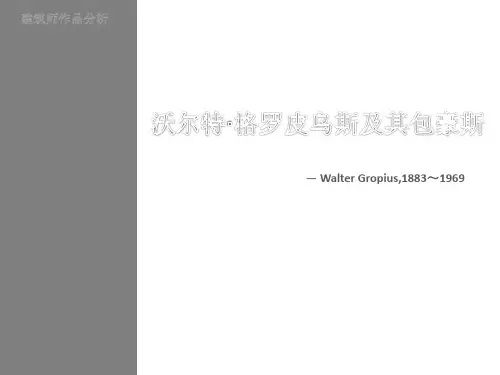
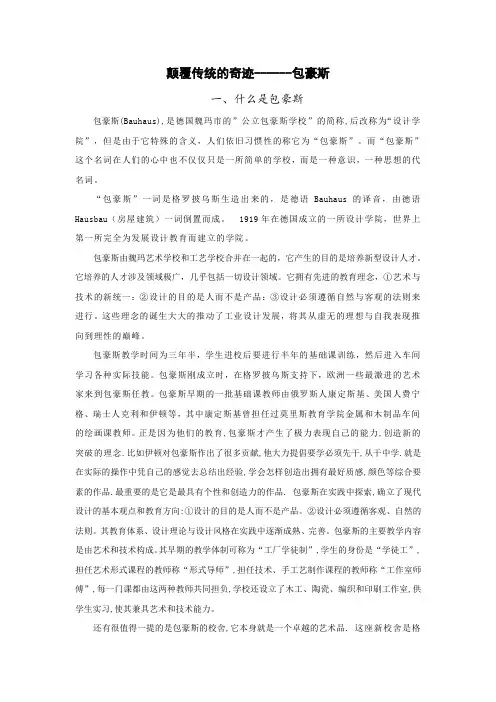
颠覆传统的奇迹------包豪斯一、什么是包豪斯包豪斯(Bauhaus),是德国魏玛市的”公立包豪斯学校”的简称,后改称为“设计学院”,但是由于它特殊的含义,人们依旧习惯性的称它为“包豪斯”。
而“包豪斯”这个名词在人们的心中也不仅仅只是一所简单的学校,而是一种意识,一种思想的代名词。
“包豪斯”一词是格罗披乌斯生造出来的,是德语Bauhaus的译音,由德语Hausbau(房屋建筑)一词倒置而成。
1919年在德国成立的一所设计学院,世界上第一所完全为发展设计教育而建立的学院。
包豪斯由魏玛艺术学校和工艺学校合并在一起的,它产生的目的是培养新型设计人才。
它培养的人才涉及领域极广,几乎包括一切设计领域。
它拥有先进的教育理念,①艺术与技术的新统一:②设计的目的是人而不是产品:③设计必须遵循自然与客观的法则来进行。
这些理念的诞生大大的推动了工业设计发展,将其从虚无的理想与自我表现推向到理性的巅峰。
包豪斯教学时间为三年半,学生进校后要进行半年的基础课训练,然后进入车间学习各种实际技能。
包豪斯刚成立时,在格罗披乌斯支持下,欧洲一些最激进的艺术家来到包豪斯任教。
包豪斯早期的一批基础课教师由俄罗斯人康定斯基、美国人费宁格、瑞士人克利和伊顿等,其中康定斯基曾担任过莫里斯教育学院金属和木制品车间的绘画课教师。
正是因为他们的教育,包豪斯才产生了极力表现自己的能力,创造新的突破的理念.比如伊顿对包豪斯作出了很多贡献,他大力提倡要学必须先干,从干中学.就是在实际的操作中凭自己的感觉去总结出经验,学会怎样创造出拥有最好质感,颜色等综合要素的作品.最重要的是它是最具有个性和创造力的作品. 包豪斯在实践中探索,确立了现代设计的基本观点和教育方向:①设计的目的是人而不是产品。
②设计必须遵循客观、自然的法则。
其教育体系、设计理论与设计风格在实践中逐渐成熟、完善。
包豪斯的主要教学内容是由艺术和技术构成。
其早期的教学体制可称为“工厂学徒制”,学生的身份是“学徒工”,担任艺术形式课程的教师称“形式导师”,担任技术、手工艺制作课程的教师称“工作室师傅”,每一门课都由这两种教师共同担负,学校还设立了木工、陶瓷、编织和印刷工作室,供学生实习,使其兼具艺术和技术能力。
05.包豪斯(Bauhaus)全称“国立包豪斯”(Des Stuatliches Bauhaus)1919年在德国成立的一所设计学院也是世界上第一所完全为发展设计教育而建立的学院创始人:瓦尔特·格罗皮乌斯(Walter Gropius, 1883—1969)(当时36岁)(现代主义设计运动的奠基人)包豪斯:由于其锐意探索、大胆革新,而对现代主义艺术风格的形成产生了关键性的影响,从而以“包豪斯”风格闻名于世,已成为现代主义发展和现代艺术教育之路上的里程碑。
瓦尔特·格罗皮乌斯(Walter Gropius 1883—1969)1883年5月18日生殷富家庭、祖父画家、叔祖父建设家曾在柏林和慕尼黑两地学建筑早年曾在贝仑斯设计事务所工作1915年与阿尔玛·马勒结婚(奥地利现代主义作曲家古斯塔夫·马勒)1924年离婚(改嫁德表现主义奥斯卡·科科什卡)办学思想·设计理念①具有鲜明的民主主义色彩和社会主义特征。
为大众服务。
之所以采用钢筋、混凝土、玻璃、钢材等材料并倡导以简单的、无装饰的风格进行设计,主要是为了廉价,让人人住得起。
工作宿舍即体现了这一特征。
②担心随着工业化大批量生产,传统手工业的优秀特点会被消灭,因此主张建立:艺术家、工业家和技术人员的合作关系,以此改善大工业的非人格化,提高设计水平。
③强调“社团”和“集体”的重要性。
认为包豪斯应当是一个“微型理想国”,一个非政治化的社区。
④主张包豪斯要加强学生与企业之间的联系,使学生的作业同时也能是企业的项目和产品。
包豪斯宣言(1919年4月1日)主要内容:①强调建筑家、画家和雕塑家的协作,共同建立艺术殿堂(三位一体)②纯艺术应当转向应用艺术③艺术与技术的统一,艺术家与工程师的合作。
基本原则:①主张艺术与设计的新统一②强调设计的目的是人而不是产品③认为设计必须遵循自然与客观的法则来进行具有理想主义的浪漫和乌托邦精神、共产主义政治目标、建筑设计的实用主义方向和严谨的工作方法特征,也造成了包豪斯的精神内容的丰富和复杂。